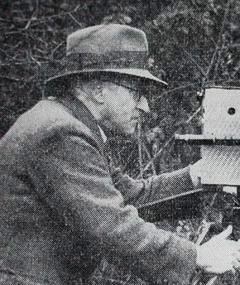Nationality British Name Oliver Pike | Years active 1900–1947 Role Photographer Movies Glimpses of Bird Life | |
 | ||
Full Name Oliver Gregory Pike Born 1 October 1877 ( 1877-10-01 ) Enfield, Middlesex Occupation naturalist, photographer, film maker Employer Pathe FreresBritish Instructional Films/ Gaumont-British Instructional Films Books In Bird‑land with Field‑glas, Nature and My Cine Camera, Bird Biographies: And Othe | ||
Oliver Gregory Pike, F.Z.S., F.R.P.S. (usually credited as Oliver G. Pike; 1 October 1877 – 17 October 1963) was a British naturalist, wildlife photographer, author and early nature documentary pioneer, specialising in the study of bird life. "His claim to significance," according to Bryony Dixon of BFI Screenonline, "lies in the groundbreaking techniques he developed to capture animals in their natural habitats and in the fact that he passed this knowledge on."
Contents
Biography
Pike studied at Enfield Grammar School until 1893, where he became friends with local commercial photographer and ornithologist Reginald Badham Lodge, who specialised in bird photography. Pike accompanied Lodge while he worked, taking his first photograph of a wild flower at the age of 13, in the autumn of 1890. In 1895 the two invented a bird-activated trip-wire releases, which effectively allowed birds to take their own pictures. Pike developed a profound knowledge of photographic techniques and went on to publish a series of 25 handbooks on ornithological photography and cinematography, starting with In Birdland with Field Glass and Camera (1900). He also developed his own stills camera, marketed as the The Birdland Camera by Sanders & Crowhurst of Shaftesbury Avenue, London, and later a cine-camera for wildlife photography that was camouflaged so as not to frighten off the subjects.
Pike's first film, In Birdland, which premiered at the Palace Theatre, London in August 1907, was the first British wildlife film to be screened to a fee paying audience. Together with cinematographer Harold Armytage Sanders, Pike took great physical risks hanging from ropes over coastal cliffs to capture unprecedented footage of Britain's seabirds, including kittiwakes, gannets, cormorants and puffins. The film proved hugely popular in its 6-week run with over 100 additional prints were made for screenings across the UK. All copies are now however believed lost or destroyed. He made two more films along a similar theme, St Kilda, Its People and Birds (1908) and Cliff Climbing – The Egg Harvest of Flamborough Head (1908), before becoming director of photography for Pathe Freres from 1910 to 1920, where he made Glimpses of Bird Life (1910), noted for its use of positioning and adjusted which were "years ahead of their time" and "helped to establish British wildlife photographers as leaders in this field."
In 1921, Pike went to work for old friend Harry Bruce Wolfe at British Instructional Films on the single-reel series Secrets of Nature series. His inaugural film for the series was The Cuckoo's Secret (1922), commissioned by Edgar Chance, which changed public perception of how common cuckoos reproduce by providing the first proof that they lay their eggs directly in the nests of the species they parasitise rather than laying them on the ground and carrying them to the nest. Over the course of the next 11 years, Smith blended "nature photography with painstaking laboratory work," on the series, "providing an atmospheric account of British wildlife," which filmmaker, historian and critic Paul Rotha described in 1930 as "the sheet anchor of the British film industry." He later went on to work for Gaumont-British Instructional Films on the similar Secrets of Life series, where he made the controversial A Family of Great Tits (1934), highlighting the brutality of nature with footage from a specially constructed nesting box. Working until 1947, he made over 50 films many of which showed animal behaviour that had never before been recorded.
Pike, represented by the Thomas's Lecture Agency of Strand, London, was a popular speaker on wildlife subjects and lectured all over the United Kingdom. He was opposed to the egg collecting, shooting and other blood sports. He was a fellow of the Royal Photographic Society and 300 prints, negatives and lantern-slides of his work, which were acquired from the London Natural History Society in 1974, are preserved at the National Media Museum in Bradford, along with one of his early cameras. He also donated several of his films to the BFI National Archive. He died in Leighton Buzzard in 1963.
Memorial
A local blue plaque for Oliver Pike, co-sponsored by Southgate District Civic Trust and Enfield Grammar School was unveiled on 16 November 2014 by his grandsons Jonathan and Richard Dollimore at 96 Green Dragon Lane, Winchmore Hill, his family home from 1882 to 1914.
Films
DVD
The Cuckoo's Secret is available on the BFI DVD Secrets of Nature, released in 2010.
